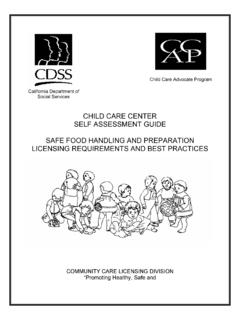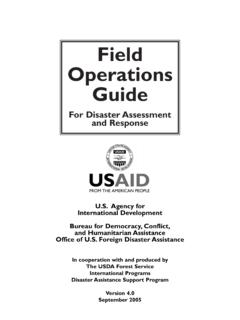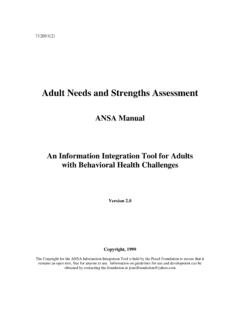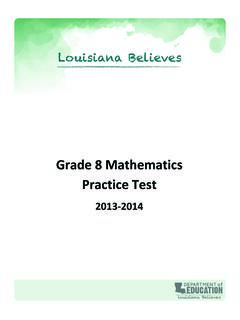Transcription of PIP Assessment Guide - assets.publishing.service.gov.uk
1 PIP Assessment Guide Part One - The Assessment Process A DWP guidance document for providers carrying out assessments for Personal Independence Payment Updated on 30 September 2019. 1. Foreword This document has been produced by the Department for Work and Pensions (DWP) to provide guidance for Assessment providers (APs) carrying out assessments for Personal Independence Payment (PIP). It is intended to supplement the contract documents agreed with APs as part of the commercial process, providing guidance for health professionals (HPs). carrying out Assessment activity and for those responsible for putting in place and delivering processes to ensure the quality of assessments. All HPs undertaking assessments on behalf of DWP must be registered practitioners who have also met requirements around training, experience and competence. This document must be read with the understanding that, as experienced practitioners and trained disability analysts, HPs will have detailed knowledge of the principles and practice of relevant consultation and examination techniques and therefore such information is not contained in this guidance.
2 In addition, the guidance is not a stand-alone document, and should form only a part of the training and written documentation that HPs receive from APs. It must be remembered that some of the information may not be readily understood by those who are not trained and experienced HPs. The Guide focuses specifically on the role of HPs in the Assessment and the quality of their work. It is not intended to cover all the requirements placed on APs as part of the PIP Assessment contracts, their full business processes, or work carried out by DWP to monitor and manage AP performance. 2. There are three parts to the Guide for Assessment providers (APs) carrying out assessments for Personal Independence Payment (PIP). Each Guide focuses on a different part of the process as detailed below: Part One The Assessment Process Part Two The Assessment Criteria Part Three Health Professional Performance 3. Contents 1 Introduction.
3 6. About Personal Independence Payment .. 6. The structure of PIP .. 6. The PIP claimant journey .. 7. The PIP Assessment .. 8. The Health Professional role .. 9. Carrying out PIP assessments .. 11. The PIP Assessment 11. Case received into DWP .. 11. Case received from DWP .. 11. Initial review of case file .. 12. Further evidence needed .. 14. Sources of further 14. Seeking further evidence from professionals .. 15. Harmful Information .. 16. From Autumn 2016 .. 16. Confidential information .. 16. Seeking further information from the claimant .. 17. Paying for Further Evidence .. 17. Late return of Further Evidence .. 17. Paper-based reviews .. 18. Cases that should not require a face-to-face consultation .. 19. Cases that are likely to require a face-to-face consultation .. 19. Face-to-face consultation .. 20. Interview skills .. 21. Inconsistencies in the level of functional limitations .. 21. History of conditions.
4 22. Social and occupational history .. 23. Employment .. 23. Functional history including the typical day' .. 24. Informal observations .. 25. Functional examination .. 27. Concluding the face-to-face consultation .. 29. Uncooperative claimants .. 29. Companions at consultations .. 29. Audio recording of PIP consultations .. 30. Restrictions on claimants' use of 31. Covert recording of consultations .. 31. Note-taking during the consultation .. 32. Young people .. 32. Unexpected findings .. 33. Home consultations .. 33. Home consultations and further evidence .. Error! Bookmark not defined. 4. Special rules for terminally ill claimants .. 35. Referral procedure .. 35. HP advice in SRTI 36. Further evidence in SRTI claims .. 36. Contacting claimants in SRTI 37. Referrals of claimants already in receipt of benefits for terminal illness .. 38. Form DS1500 received without a claim form .. 38. Claimant questionnaire or further evidence suggests SRTI applies in standard 38.
5 Author has misunderstood the purpose of the DS1500 .. 39. Completing Assessment reports .. 40. Choosing descriptors .. 40. Claimants applying for PIP from outside the UK .. 41. Evaluation and analysis of evidence .. 41. Summary justification .. 42. Variability .. 43. Requirements of a justified 43. Who will see the report?.. 44. 45. Advising on prognosis .. 45. Completing the prognosis advice on the Assessment report .. 46. Award Review dates .. 47. No Review Required .. 47. Specification of a Review Period .. 48. Award Reviews .. 50. Identifying claimants who require additional support with the PIP. process .. 51. Requests for Supplementary Advice .. 53. Advice on substantially the same condition .. 55. Case studies of such considerations are as follows: .. 56. Consent and Confidentiality .. 57. Consent .. 57. Timescales for consent 58. Consent to a physical 58. Appointees .. 58. Power of Attorney/Deputy .. 60. Proof of consent.
6 60. Consent in third party claims .. 61. Confidentiality .. 63. Telephone conversations .. 63. Releasing information to a claimant or third party .. 63. Glossary .. 64. 5. 1 Introduction About Personal Independence Payment Personal Independence Payment (PIP) is a benefit for people with a long-term health condition or impairment, whether physical, sensory, mental, cognitive, intellectual, or any combination of these. It is paid to make a contribution to the extra costs that disabled people may face, to help them lead full, active and independent lives. The benefit is not means tested and is non-taxable and non- contributory. This means that entitlement to the benefit is not dependent on a person's financial status or on whether they have paid National Insurance contributions. PIP can be paid to those who are in full or part-time work as well as those out of work. PIP was introduced in April 2013 for people aged 16 to 64 years and is replacing Disability Living Allowance (DLA) for adults.
7 The roll-out of PIP to existing DLA claimants commenced from October 2013. DLA claimants aged under 16 and those who were aged 65. or over on 8 April 2013 will not be affected. The structure of PIP. PIP has two components: Daily Living intended to act as a contribution to the extra cots disabled people face in their day to day lives that do not relate to mobility; and Mobility intended to act as a contribution to the extra costs disabled people face in their day to day lives that relate to mobility. 6. The PIP claimant journey Claimants currently make an application for PIP by phone and once basic entitlement conditions are established, the claimant is asked to complete the How your disability affects you questionnaire, referred to in this Guide as the claimant questionnaire'. At this stage claimants are encouraged to provide any supporting evidence they already have that they feel should be considered alongside their claim information - for example evidence from a health or other professional involved in their care or treatment.
8 Once the claimant questionnaire has been returned to DWP, the case is referred to an Assessment provider (AP) along with any supporting evidence provided. The AP then conducts the Assessment , gathering any further evidence necessary before providing an Assessment report to DWP. If the claimant questionnaire is not returned and the claimant has been identified as having a mental or cognitive impairment, the claim will be referred directly to the AP for Assessment . If the 7. individual is claiming under the Special Rules for Terminal Illness (SRTI), the case is instead referred directly to the AP and dealt with as a priority. Once all evidence gathering has taken place, including a face- to-face Assessment with a HP where appropriate, the DWP Case Manager (CM) will review the claim and all evidence provided and make a decision regarding the award of benefit. If the claimant is unhappy with the decision on their award, they have the right of reconsideration and, if a claimant disagrees with the reconsideration, they have the right to appeal to Her Majesty's Courts and Tribunal Service (HMCTS).
9 The PIP Assessment The Assessment for PIP looks at an individual's ability to carry out a series of everyday activities. The Assessment considers the overall impact of a claimant's health condition or impairment on their functional ability, rather than focusing on a particular diagnosis. PIP is not a compensation payment for ill health /. disability; it is to help people with the increased costs of daily living in cases of long term ill health or disability. PIP sits alongside support provided by the NHS and local authorities and is not meant to duplicate that support. The activities explored during the PIP Assessment are: Daily Living (10 activities): preparing and cooking a simple meal taking nutrition managing therapy or monitoring a health condition washing and bathing managing toilet needs or incontinence dressing and undressing communicating verbally reading and understanding signs, symbols and words engaging with other people face-to-face making budgeting decisions 8.
10 Mobility (2 activities): planning and following journeys moving around Each activity contains a series of descriptors which describe increasing levels of difficulty with carrying out the activity. The HP. will choose a descriptor for each activity and a DWP CM will review the suggested descriptors and decide if the evidence supports those choices. Each descriptor has a score. The total scores for all of the activities related to each component determine entitlement for that component. The entitlement threshold for each component is 8. points for the standard rate and 12 points for the enhanced rate. The Health Professional role The HP's role is to assess the overall functional effects of the claimant's health condition or impairment on their everyday life over a 12 month period, using the Assessment criteria. The key elements of the HP's role in PIP are to: Consider information in the claimant questionnaire and any supporting evidence provided along with it Determine whether a claim can be assessed on the basis of a paper review and provide appropriate advice Determine whether any additional evidence needs to be gathered from health or other professionals supporting the claimant Carry out face-to-face consultations as required Having considered all the information and evidence of the case, produce a report for DWP containing information on the claimant's circumstances and recommendations on the Assessment criteria.















